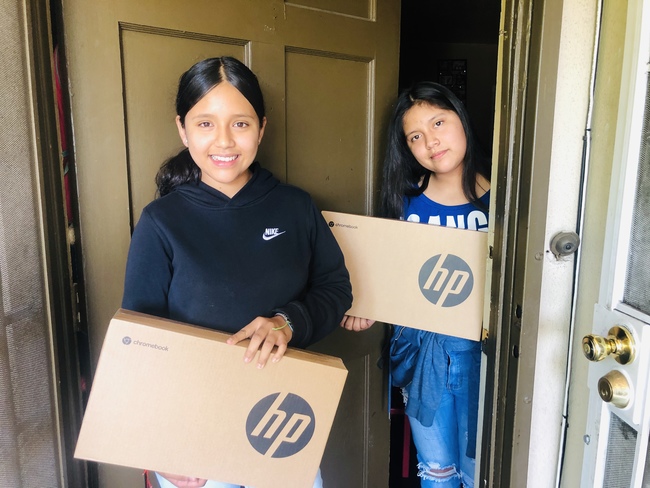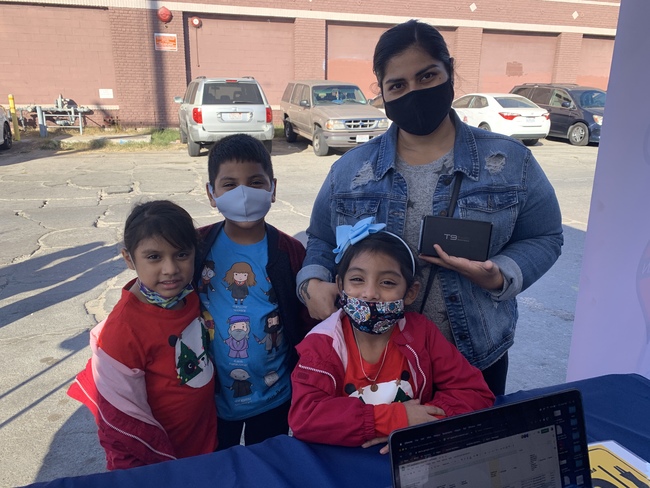Low Internet Access Drives Digital Divide During COVID-19
When the COVID-19 outbreak began in Los Angeles during March 2020, County leadership was quick to roll out several measures to stem the spread of the virus, including the closure of public schools. In April of 2020, the Neighborhood Data for Social Change (NDSC) platform released a data story discussing the recent school closures and efforts by the Los Angeles School District (LAUSD), KCET and the Los Angeles Community College District (LACCD) to coordinate remote learning for students of all ages across the County. Now, several months into the pandemic, this story examines the challenges families face with remote learning. We partnered with SOLA Impact, a community development organization located in South Los Angeles, to better understand how they are working to address those challenges.
Though initially announced as a two-week shutdown, all-remote learning for LAUSD schools has remained in place to date. LA County’s swift response stands in contrast to other states’ and countries’ efforts to “flatten the curve,” including those in some European countries which have favored keeping classrooms open and instead temporarily closing restaurants and bars. Cities such as New York have made efforts to keep the public school system in-person, implementing temporary closures only when case positivity rates reach a certain point.
Disparities in Internet Quality
After the closure of public schools in LA County, many expressed concerns that students would have differing access to resources, depending on geography, immigrant status, and socioeconomic factors, among other issues. Further, critics publicly questioned whether certain students would lack the technological capabilities necessary to complete homework, including reliable internet connectivity. In order to address this technological gap, LAUSD distributed laptops and tablets to students in need, and worked with internet companies to provide free access to hotspots and waive monthly fees.

Despite the large effort to mitigate internet connectivity issues for LAUSD students, there is still increased need for internet service than what was initially reported. In addition, the shift brought on by the COVID-19 pandemic towards working and learning remotely has put a huge strain on digital infrastructure, especially in already underserved neighborhoods. For example, LAUSD has been working with Verizon to provide unlimited internet access to LAUSD students. However, Verizon has low coverage in certain neighborhoods, including South LA, such that cellphone-dependent hotspots in the area have been overextended and unable to meet the needs of distance learning.
Other factors also contribute to this digital divide. For example, remote learning relies in part on parents serving as their children’s educators and responding to other student needs that emerge from distance learning. This is challenging for many families, especially those from low-income backgrounds, as many parents may be required to continue working outside the home. Some parents also have language barriers and/or may not have the technological proficiency to help with technical issues that are a byproduct of remote learning. Additionally, in low-income neighborhoods where overcrowded housing is common, digital infrastructure is especially strained and many school-aged children have struggled to find the space for uninterrupted instruction. A report from the USC Rossier School of Education and the USC Annenberg School for Communication and Journal found that only 1 in 3 families surveyed said they had a place free of distraction for remote learning.
Overview of SoLa Impact
SoLa Impact is a family of social impact funds targeting the refurbishment and development of high quality affordable housing throughout South Los Angeles. SoLa Impact is rooted in three social impact priorities: 1) a housing first approach to solving homelessness through new ground up development; 2) catalyzing local economic development through the nation’s first Opportunity Zone business campus called the Beehive; 3) opening access to technology education and career opportunities for youth in South LA. To open new tech pathways, SoLa Impact is building South LA’s first Technology and Entrepreneurship Center to help teach and inspire the next generation of tech workers and entrepreneurs from South Los Angeles. SoLa Impact is proud to be the largest private landlord of Section 8 housing in the City of LA and was named the 7th fastest growing minority-led company in the US by INC. in 2020. In December 2020, SoLa Impact launched the Black Impact Fund, a $1B fund aimed at opening new access to high quality affordable housing and economic opportunity in Black and brown communities around the country.
Due to COVID-19, many of SoLa Impact’s low-income tenant families continue to struggle to secure and pay for high quality internet access to support remote learning. A survey of their residents found that 21% of households did not have broadband internet service and 44% lacked adequate internet access to meet the needs of remote learning due to poor quality and speed. 76% of households reported they required assistance to pay their internet bill, and 40% said their child’s current device did not meet the needs for their classes. Additionally, half of households reported that they do not have a workable laptop.
SoLa resident data was collected from a phone interview conducted on 125 households in late September 2020 to survey the access to internet and technology resources in South LA.

In response to the urgent demonstrated need for better tools and connectivity in South LA, SoLa Impact has partnered with companies like T-mobile, AT&T, the LA Rams, LA Kings, Comp-u-dopt, Human IT and Wells Fargo to provide free internet access and laptops to low-income families. Almost 200 laptops and chromebooks have been distributed to families. Their recently launched initiative, called the “1000 for 1000” initiative will provide 1000 families with free internet for 1000 days. 425 families have already been approved to receive T-mobile hotspots that provide high speed internet, no data limits, and are free of charge for almost three years.
Conclusion
Even months after schools were closed, access to adequate technology continues to pose a significant barrier for many students. Without sufficient connectivity and devices that meet the needs of distance learning, students may struggle to stay connected to their school and their assignments, facing academic hardship. SoLa Impact’s partnerships with AT&T and T-Mobile and AT&T aim to provide families with the necessary learning tools in order to achieve better learning outcomes and shrink the digital divide.
For more information on how to apply for free internet click here or emailgetwifi@solaican.org

Mackenzie Goldberg
Mackenzie Goldberg is a Master of Urban Planning student at USC Price. She holds a bachelor’s degree in Religious Studies from Reed College in Portland, OR. Prior to coming to USC, Mackenzie worked as a writer and editor for an architectural publication based in Los Angeles, CA, where she came to understand the many ways in which policy undergirds our built environment. Her research interests lie at the cross-sector of planning policy, urban design, and community organizing. Through her work, she hopes to better engage communities in the systems that govern our cities.
Sources
Aguilar, S. J., Galperin, H., Baek, C., & Gonzalez, E. (2020, October 14). When school comes home: How low-income families are adapting to distance learning. https://doi.org/10.35542/osf.io/su8wk
Esquivel, Paloma, and Blume, Howard (Sept 15, 2020). Tens of thousands of L.A.-area students still need computers or Wi-Fi 6 months into pandemic. Accessed 01/08/2020 from: https://www.latimes.com/california/story/2020-09-15/tens-of-thousands-of-la-county-students-still-need-computers-and-hot-spots-six-months-into-school-closures
Onishi, Norimitsu, Méheut, Constant, and Francini, Antonella (Nov 30, 2020). Positive Test Rate of 11 Percent? France’s Schools Remain Open. Accessed 01/08/2020 from: https://www.nytimes.com/2020/11/30/world/europe/france-covid-schools.html
Shapiro, Eliza (Nov 18, 2020). New York City to Close Public Schools Again as Virus Cases Rise. Accessed 01/08/2020 from: https://www.nytimes.com/2020/11/18/nyregion/nyc-schools-covid.htmlA
Photo Attributions
All photos courtesy of SoLa Impact

